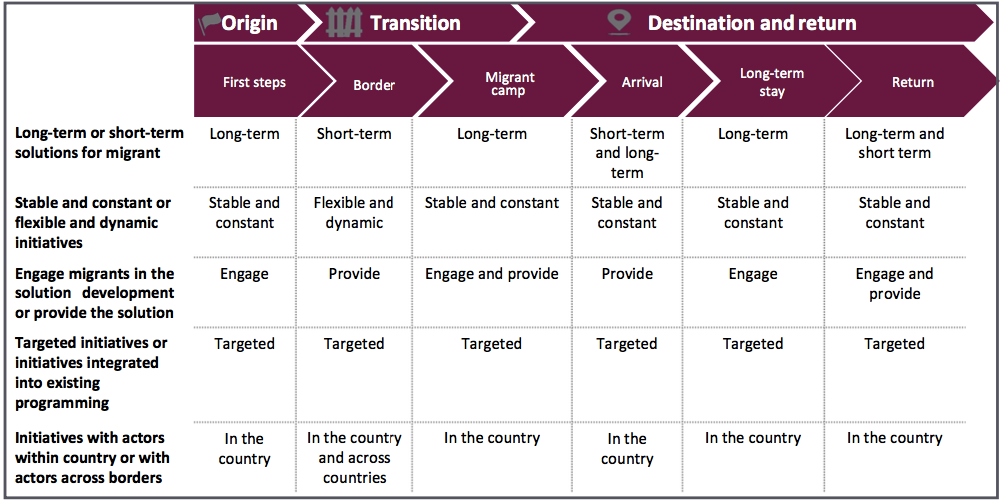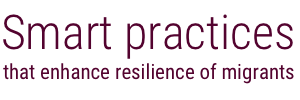Annex A – How this report can be used
National Societies can use this report to re-assess their role and redefine their response.
National Societies can use this report as an inspiration to re-assess their role in addressing the needs of migrants, or to redefine their responses by integrating aspects of smart practices implemented by other National Societies.
The graph below provides an overview of the key steps that National Societies can follow when using this report. These steps are further detailed in the pages that follow.
1. Identify the role of the National Society
2. Identify smart practices
3. Implement the response
1a. Identify migrant needs
If National Society is already implementing a smart practice
3a. Share learning with other actors (including National Societies); and continue with response
1b. Map responses to needs and identify gaps
If a smart practice exists, but the National Society is not implementing it
3b. Adapt the smart practice to local context
1c. Strategically decide which gaps the National Society should fill and for which it should act as a guarantor
If a smart practice does not exist
3c. Create a new smart practice using the policy principles
1a. Identify migrant needs.
First, National Societies should conduct a needs/vulnerability assessment, using a migration lens. As seen above, the IFRC can provide support to develop the needs and vulnerability assessment, if needed. We also encourage the National Society to share the findings with the IFRC and the global community.
1b. Map responses to needs and identify gaps
Second, National Societies should develop a high-level mapping of what national stakeholders are doing to address the needs of migrants in the country. (The templates and frameworks presented in this report can be used, if deemed relevant.) The map should be accompanied by a high-level estimate of the proportion of the need that the responses are addressing.
Given that it might be difficult to assess the exact proportion of need that is being addressed, we suggest using a high-level estimate of three categories. The three categories should indicate if existing responses address: a small proportion of the need, approximately half of the need, or almost all the need.
1c. Strategically decide which gaps the National Society should fill and for which it should act as a guarantor
Third, National Societies should prioritize which gaps to fill, and for which to act as a guarantor. Before deciding whether or not to address the gaps, National Societies should ask themselves whether other actors could address the need better than them. Some questions include:
- Could another organization address the need in a better, more cost-effective way than the National Society?
- If so, can the National Society find a way to encourage it to do so?
- Does the National Society have relevant experience?
- If not, could it gain it?
- Does the National Society have sufficient resources to address the gap?
- If not, could it mobilize it?
2. Identify smart practices
If a National Society decides to start addressing an unmet need, or to address an unmet need differently, they can use this report for inspiration.
- National Societies can find examples of how other National Societies are addressing common needs in a particular step of the journey, by referring to the relevant section (step in the journey and dimension of resilience) in the report.
The report does not provide operational guidelines on how to implement smart practices. Instead we encourage interested National Societies to contact National Societies with the relevant experience. This way direct and relevant experience can be shared. Links and contact details of National Societies are provided in the report.
- Moreover, we encourage National Societies to also review other smart practices that address the same needs, in other steps of the migration journey. For example, one smart practice might address the need for practical information at transition, through an information sheet. While this smart practice is presented in the transition section of this report, the smart practice might also be relevant for National Societies in origin or destination countries.
3a. If the National Society is already implementing a smart practice; share learning
If a National Society is already implementing a smart practice, we encourage it to share its experiences with other National Societies. We propose two mechanisms for doing so:
- If the smart practice is currently not featured in one of the templates, we encourage the National Society to complete a template, and share it, in order to include it in the report.
- If the smart practice is included (or once it has been included), we encourage the National Society to share its experience with other interested National Societies.
- This might be done by responding to requests for information from interested National Societies by email or phone, or through the common ‘discussion forum’ on the migration website.
- In addition, there might be other platforms organized by the secretariat to share experiences, such as webinars, workshops, etc.
3B: If a smart practice exists and a National Society wants to use it; contextualize it.
If a National Society is interested in adopting a smart practice implemented by another National Society, we encourage it to contact the relevant National Society to learn from its experience, and then contextualize the practice in their country. Some of the questions that a National Society can consider when contextualizing a smart practice include:
- Will there be legal or governmental support to implement the smart practice?
- If not, how can the National Society ensure governmental support?
- Are there any existing initiatives or structures that the National Society can work from?
- Are there local partners that the National Society can rely on, for at least part of the response?
- What features of the migration need to be considered (e.g., are migrants labour migrants or refugees, in transit or settled, etc.)? What cultural aspects need to be considered?
- What other national factors need to be taken into consideration (such as geographical distribution, cultural norms, etc.)?
3c: If a smart practice does not exist, create a new smart practice
When defining a new initiative, National Societies should first take into consideration the IFRC’s migration policies.
In addition, they can consider some of the characteristics observed among the smart practices in a specific step in the migration journey. These characteristics have been highlighted throughout the report, and are summarized in the table below.

